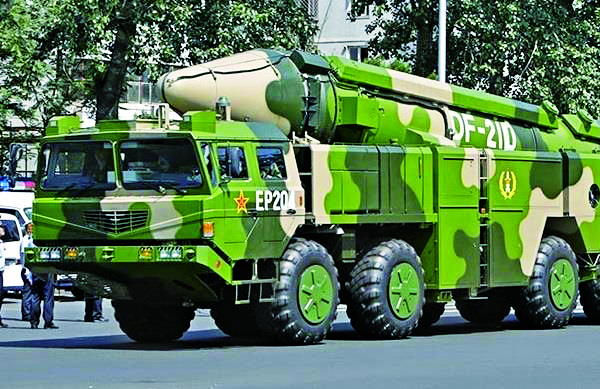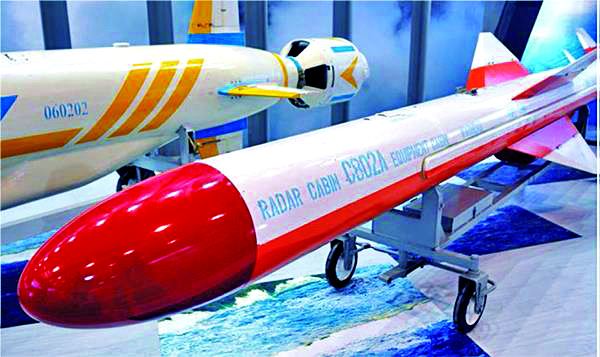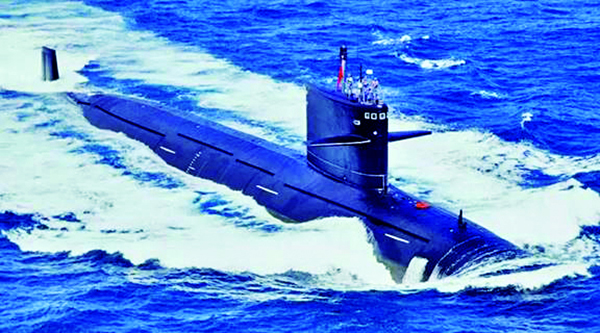Anti-Ship Ballistic Missiles (ASBMs)
China is fielding two types of land-based ballistic missiles with a capability of hitting ships at sea-the DF-21D, a road-mobile anti-ship ballistic missile (ASBM) with a range of more than 1,500 kilometers (i.e., more than 910 nautical miles), and the DF-26, a road-mobile, multi-role intermediate range ballistic missile (IRBM) with a maximum range of about 4,000 kilometers (i.e., about 2,160 nautical miles) that DOD says “capable of conducting both conventional and nuclear precision strikes against ground targets as well as conventional strikes against naval targets.”
Until 2020, reported test flights of DF-21s and SDF-26s had not involved attempts to hit moving ships at sea. A November 14, 2020, press report, stated that an August 2020 test firing of DF-21 and DF-26 ASBMs into the South China resulted in the missiles successfully hitting a moving target ship south of the Paracel Islands. A December 3, 2020, press report stated that Admiral Philip Davidson, the commander of U.S. Indo-Pacific Command, “confirmed, for the first time from the U.S. government side, that China’s People’s Liberation Army has successfully tested an anti-ship ballistic missile against a moving ship.”
In April 2022, it was reported that China may have developed a new type of ASBM, perhaps designed the YJ-21, that is small enough to fit into the vertical launch tube of a surface combatant, and that China had test fired such a weapon from a Type 055 cruiser (or large destroyer).
China reportedly is also developing hypersonic glide vehicles that, if incorporated into Chinese ASBMs, could make Chinese ASBMs more difficult to intercept.
Observers have expressed strong concerns about China’s ASBMs, because such missiles, in combination with broad-area maritime surveillance and targeting systems, would permit China to attack aircraft carriers, other U.S. Navy ships, or ships of allied or partner navies operating in the Western Pacific. The U.S. Navy has not previously faced a threat from highly accurate ballistic missiles capable of hitting moving ships at sea. For this reason, some observers have referred to ASBMs as a “game-changing” weapon.
Anti-Ship Cruise Missiles (ASCMs)
China’s extensive inventory of anti-ship cruise missiles (ASCMs) includes both Russian- and Chinese-made designs, including some advanced and highly capable ones, such as the Chinese-made YJ-18.
Although China’s ASCMs do not always receive as much press attention as China’s ASBMs (perhaps because ASBMs are a more-recent development), observers are nevertheless concerned about them. As discussed later in this report, the relatively long ranges of certain Chinese ASCMs have led to concerns among some observers that the U.S. Navy is not moving quickly enough to arm U.S. Navy surface ships with similarly ranged ASCMs.
Press reports in April 2019 and December 2021 state that China might be developing a YJ-18 launcher that can be packaged inside a standard commercial shipping container, for the potential purpose of surreptitiously deploying YJ-18s on merchant ships, a capability that, if implemented, could violate the law of naval warfare.
Submarines
Overview
China has been steadily modernizing its submarine force, and most of its submarines are now built to relatively modern Chinese and Russian designs. Qualitatively, China’s newest submarines might not be as capable as Russia’s newest submarines, but compared to China’s earlier submarines, which were built to antiquated designs, its newer submarines are much more capable.
Types and Numbers
Most of China’s submarines are non-nuclear-powered attack submarines (SSs). China also operates a small number of nuclear-powered attack submarines (SSNs) and a small number of nuclear-powered ballistic missile submarines (SSBNs). The number of SSNs and SSBNs may grow in coming years, but the force will likely continue to consist mostly of SSs. DOD states that “the PLAN has placed a high priority on modernizing its submarine force, but its force structure continues to grow modestly as it works to mature its force, integrate new technologies, and expand its shipyards. The PLAN will likely maintain between 65 and 70 submarines through the 2020s, replacing older units with more capable units on a near one-to-one basis.” ONI states that “China’s submarine force continues to grow at a low rate, though with substantially more-capable submarines replacing older units. Current expansion at submarine production yards could allow higher future production numbers.” ONI projects that China’s submarine force will grow from a total of 66 boats (4 SSBNs, 7 SSNs, and 55 SSs) in 2020 to 76 boats (8 SSBNs, 13 SSNs, and 55 SSs) in 2030.
China’s newest series-built SS design is the Yuan-class (Type 039) SS, its newest SSN class is the Shang-class (Type 093) SSN, and its newest SSBN class is the Jin (Type 094) class SSBN.
DOD states that “the PRC continues to increase its inventory of conventional submarines capable of firing advanced anti-ship cruise missiles (ASCMs). Between the mid-1990s and mid-2000s, the PLAN purchased 12 Russian-built Kilo class SS units, eight of which are capable of launching ASCMs. China’s shipyards have delivered 13 Song class SS (Type 039) and 17 Yuan class diesel-electric (SSPs) (Type 039A/B). The PRC is expected to produce a total of 25 or more Yuan class submarines by 2025.” DOD states further:
“Over the past 15 years, the PLAN has constructed twelve nuclear submarines-two Shang I class SSNs (Type 093), four Shang II class SSNs (Type 093A), and six Jin class SSBNs (Type 094). Equipped with the CSS-N-14 (JL-2) submarine-launched ballistic missile (SLBM), the PLAN’s six operational Jin class SSBNs represent the PRC’s first credible sea-based nuclear deterrent. Each Jin class SSBN can carry up to 12 JL-2 SLBMs. In 2019, Beijing displayed these missiles at the PRC’s 70th anniversary parade, revealing that at least a full complement of 12 JL-2s are complete and operational. The PRC’s next-generation Type 096 SSBN, which likely began construction in the early 2020s, will reportedly carry a new type of SLBM. The PLAN is expected to operate the Type 094 and Type 096 SSBNs concurrently and could have up to eight SSBNs by 2030. This would align with Chairman Xi Jinping’s 2018 directive for the SSBN force to achieve “stronger growth.”
By the mid-2020s, the PRC will likely build the Type 093B guided-missile nuclear attack submarine. This new Shang class variant will enhance the PLAN’s anti-surface warfare capability and could provide a clandestine land-attack option if equipped with land-attack cruise missiles (LACMs).
In February 2022, the first of a new class of SS, smaller than the Yuan design, was reported, but it is not clear whether this design is intended for China’s navy, for export to other countries, or both.
A May 16, 2022, press report states:
“A submarine seen in a satellite photo of a Chinese shipyard shows what could be a new class or subtype of a nuclear-powered attack sub with a new stealthy propulsion system and launch tubes for cruise missiles.”
The satellite photo of the shipyard at Huludao in Liaoning province, northern China, which was provided to Defense News by Planet Labs, was taken May 3 and shows a submarine on a drydock.
The unidentified boat’s presence at the yard was first noted in an April 29 satellite image by geospatial intelligence outfit AllSource Analysis. The organization said the submarine is possibly a new class undergoing construction by China.
Submarine Weapons
China’s submarines are armed with one or more of the following: ASCMs, wire-guided and wake-homing torpedoes, and mines. Wake-homing torpedoes can be very difficult for surface ships to decoy. Each Jin-class SSBN is armed with 12 JL-2 nuclear-armed submarine-launched ballistic missiles (SLBMs). A May 2, 2021, press report stated that China’s latest Jin-class SSBN is armed with a new and longer-ranged SLBM called the JL-3.
Based on the US Congressional Reserach Service Report on China Naval Modernisation, Nov 2022





















